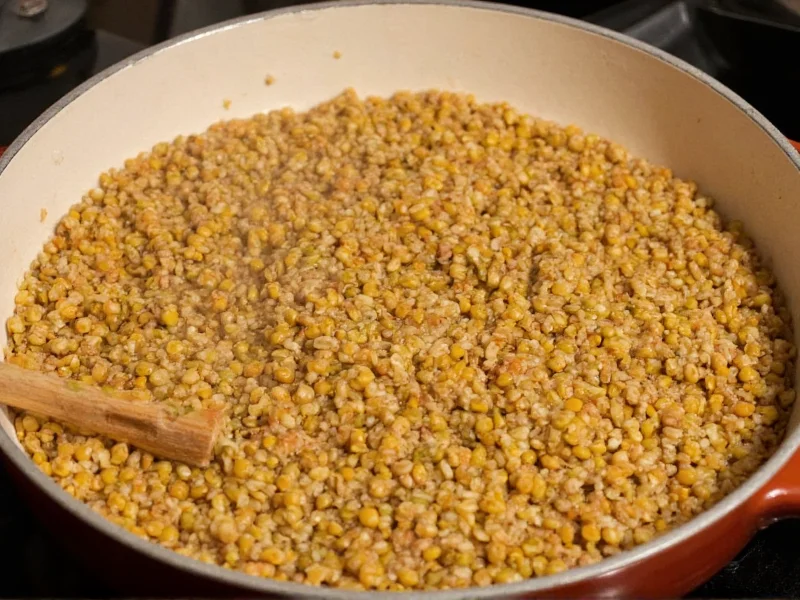Lentils are nutritional powerhouses packed with protein, fiber, and essential minerals. Unlike many legumes, they don't require soaking and cook relatively quickly, making them perfect for weeknight meals. This comprehensive guide covers everything you need to know about cooking lentils perfectly every time, whether you're using a stovetop, Instant Pot, or slow cooker.
Understanding Lentil Varieties and Their Cooking Needs
Not all lentils are created equal when it comes to cooking. Each variety has unique characteristics that affect cooking time and final texture. Choosing the right lentil for your recipe ensures optimal results.
| Lentil Type | Color | Cooking Time (Stovetop) | Best Uses |
|---|---|---|---|
| Green Lentils | Olive green | 25-35 minutes | Salads, side dishes, casseroles (hold shape well) |
| Brown Lentils | Earthy brown | 20-30 minutes | Stews, soups, curries (most versatile) |
| Red/Yellow Lentils | Orange to yellow | 15-20 minutes | Dals, purees, thickening soups (mash easily) |
| Black (Beluga) | Deep black | 25-30 minutes | Salads, pilafs (caviar-like appearance) |
| Puy Lentils | Dark green with gray spots | 25-30 minutes | Salads, gourmet dishes (peppery flavor) |
Perfect Stovetop Cooking Method
The traditional stovetop method produces consistently excellent results for how to cook lentils on stove. Use a 2.5:1 liquid-to-lentil ratio (2.5 cups liquid per 1 cup lentils). For optimal flavor, use vegetable or chicken broth instead of water. Add aromatics like bay leaves, garlic, or onions to the cooking liquid for enhanced taste. Bring to a boil, then immediately reduce to the lowest possible simmer. Cover with a lid slightly ajar to allow steam to escape. Check tenderness starting at 15 minutes for red lentils or 25 minutes for green varieties. Drain any excess liquid once cooked to your desired tenderness.
Historical Evolution of Lentil Cooking Techniques
Lentil preparation methods have undergone significant technological evolution, directly impacting modern cooking efficiency:
- Pre-Industrial Era (8,000 BCE - 1800s): Cooked in clay pots over open fires requiring 45-60 minutes, with inconsistent results due to variable heat control.
- Early Pressure Technology (1679-1938): Denis Papin's "Steam Digester" (1679) reduced cooking time by 30%, but home pressure cookers only became practical after National Pressure Cooker Company's standardized models (1938).
- Modern Electric Appliances (2010-Present): Instant Pot's multi-cooker technology (patented 2010) cuts cooking time by 65-75% versus traditional methods. University of Minnesota Extension confirms pressure cooking reduces legume preparation time by up to two-thirds through elevated boiling points (UMN Extension).
This progression demonstrates how technological advances transformed lentils from time-intensive staples to accessible weeknight ingredients.
Alternative Cooking Methods
Instant Pot Lentil Recipe
For those wondering how to cook lentils in an Instant Pot, use a 1:1.4 liquid-to-lentil ratio. Cook on high pressure for 8-10 minutes for red lentils or 12-15 minutes for green/brown varieties, followed by a 10-minute natural pressure release. This method significantly reduces lentil cooking time by type while maintaining texture.
Slow Cooker Method
Combine lentils with 3 cups liquid per 1 cup lentils in your slow cooker. Cook on low for 3-4 hours. This method works best for soups and stews where lentils will break down slightly.
Troubleshooting Common Lentil Problems
Why are my lentils still hard? This typically happens when cooking at too low a temperature, using old lentils, or adding acidic ingredients too early. Ensure your liquid is at a gentle simmer throughout cooking.
Do lentils need to be soaked before cooking? Unlike beans, lentils don't require soaking, though a quick rinse is essential. Soaking may reduce cooking time slightly but can cause smaller varieties like red lentils to become mushy.
Why did my lentils turn out mushy? Overcooking, using too much liquid, or adding salt too early can cause this issue. For firmer lentils in salads, undercook slightly and let them finish cooking in the residual heat.
Critical Context Factors and Limitations
Successful lentil preparation depends on environmental variables often overlooked in standard guides. These context boundaries significantly impact outcomes:
- Altitude Constraints: Above 3,000 feet elevation, water boils below 212°F (100°C), increasing cooking time by 15-20%. Colorado State University Extension recommends adding 5 minutes per 1,000 feet of elevation beyond 3,000 feet (CSU Extension).
- Water Hardness Effects: Calcium/magnesium in hard water impedes softening. University of Nebraska Extension testing shows lentils cooked in hard water (over 120 ppm) require 20% longer cooking and may remain gritty (UNL Food Safety).
These factors explain why identical recipes yield different results across locations, emphasizing the need for context-aware adjustments.
Flavor Enhancement and Serving Suggestions
Add salt only during the last 5-10 minutes of cooking to prevent toughening. Acidic ingredients like tomatoes or vinegar should also be added toward the end. For an instant pot lentil recipe with maximum flavor, sauté aromatics first before pressure cooking. Pair cooked lentils with complementary flavors: cumin and coriander for Indian dishes, rosemary and thyme for European preparations, or lemon and parsley for Mediterranean salads.
Storage and Reheating Tips
Cooked lentils keep well in the refrigerator for up to 5 days or in the freezer for 3 months. Store them in their cooking liquid to maintain moisture. When reheating, add a splash of water or broth to restore moisture. For meal prep, cook a large batch of brown lentils which hold their shape best through multiple reheating cycles.











 浙公网安备
33010002000092号
浙公网安备
33010002000092号 浙B2-20120091-4
浙B2-20120091-4